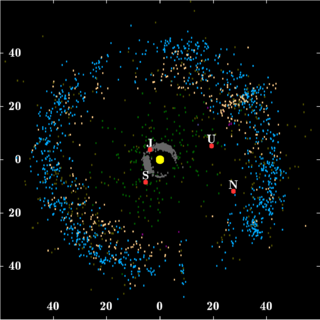
2060 Chiron is a small Solar System body in the outer Solar System, orbiting the Sun between Saturn and Uranus. Discovered in 1977 by Charles Kowal, it was the first-identified member of a new class of objects now known as centaurs—bodies orbiting between the asteroid belt and the Kuiper belt.
5145 Pholus is an eccentric centaur in the outer Solar System, approximately 180 kilometers in diameter, that crosses the orbit of both Saturn and Neptune. It was discovered on 9 January 1992 by American astronomer David Rabinowitz (uncredited) of UA's Spacewatch survey at the Kitt Peak National Observatory in Arizona, United States. The very reddish object has an elongated shape and a rotation period of 9.98 hours. It was named after the creature Pholus from Greek mythology.

In planetary astronomy, a centaur is a small Solar System body with either a perihelion or a semi-major axis between those of the outer planets. Centaurs generally have unstable orbits because they cross or have crossed the orbits of one or more of the giant planets; almost all their orbits have dynamic lifetimes of only a few million years, but there is one known centaur, 514107 Kaʻepaokaʻawela, which may be in a stable orbit. Centaurs typically exhibit the characteristics of both asteroids and comets. They are named after the mythological centaurs that were a mixture of horse and human. Observational bias toward large objects makes determination of the total centaur population difficult. Estimates for the number of centaurs in the Solar System more than 1 km in diameter range from as low as 44,000 to more than 10,000,000.

944 Hidalgo is a centaur and unusual object on an eccentric, cometary-like orbit between the asteroid belt and the outer Solar System, approximately 52 kilometers in diameter. Discovered by German astronomer Walter Baade in 1920, it is the first member of the dynamical class of centaurs ever to be discovered. The dark D-type object has a rotation period of 10.1 hours and likely an elongated shape. It was named after Mexican revolutionary Miguel Hidalgo y Costilla.

Wilhelm Heinrich Walter Baade was a German astronomer who worked in the United States from 1931 to 1959.
Scott Sander Sheppard is an American astronomer and a discoverer of numerous moons, comets and minor planets in the outer Solar System.

The scattered disc (or scattered disk) is a distant circumstellar disc in the Solar System that is sparsely populated by icy small solar system bodies, which are a subset of the broader family of trans-Neptunian objects. The scattered-disc objects (SDOs) have orbital eccentricities ranging as high as 0.8, inclinations as high as 40°, and perihelia greater than 30 astronomical units (4.5×109 km; 2.8×109 mi). These extreme orbits are thought to be the result of gravitational "scattering" by the gas giants, and the objects continue to be subject to perturbation by the planet Neptune.
39P/Oterma is a currently inactive periodic comet in the Solar System with an orbital period of nearly 20 years. The size of its nucleus is not known.

10199 Chariklo is the largest confirmed centaur. It orbits the Sun between Saturn and Uranus, grazing the orbit of Uranus. On 26 March 2014, astronomers announced the discovery of two rings around Chariklo by observing a stellar occultation, making it the first minor planet known to have rings.

1999 LE31 is a centaur and damocloid on a retrograde and eccentric orbit from the outer region of the Solar System. It was first observed on 12 June 1999, by astronomers with the LINEAR program at the Lincoln Lab's ETS near Socorro, New Mexico, in the United States. The unusual object measures approximately 16.8 kilometers (10 miles) in diameter.
A critical-list minor planet is a numbered minor planet whose orbit and position is especially in need of improvement.
This page is based on this
Wikipedia article Text is available under the
CC BY-SA 4.0 license; additional terms may apply.
Images, videos and audio are available under their respective licenses.








